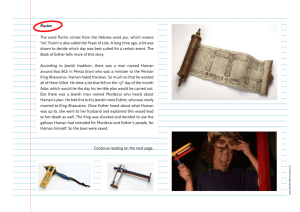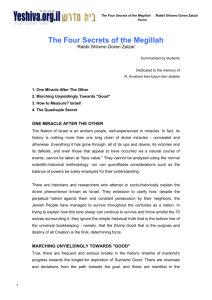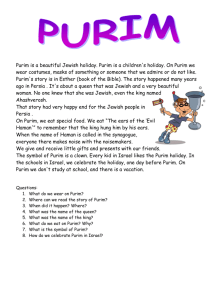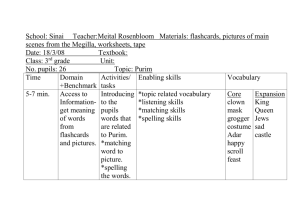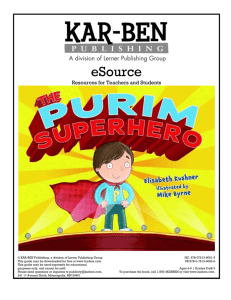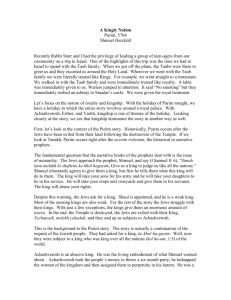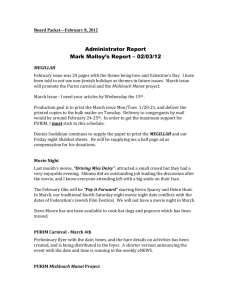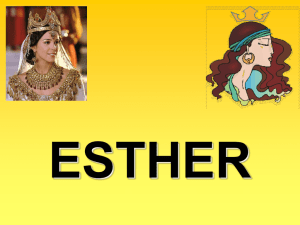Purim_My_Take
advertisement
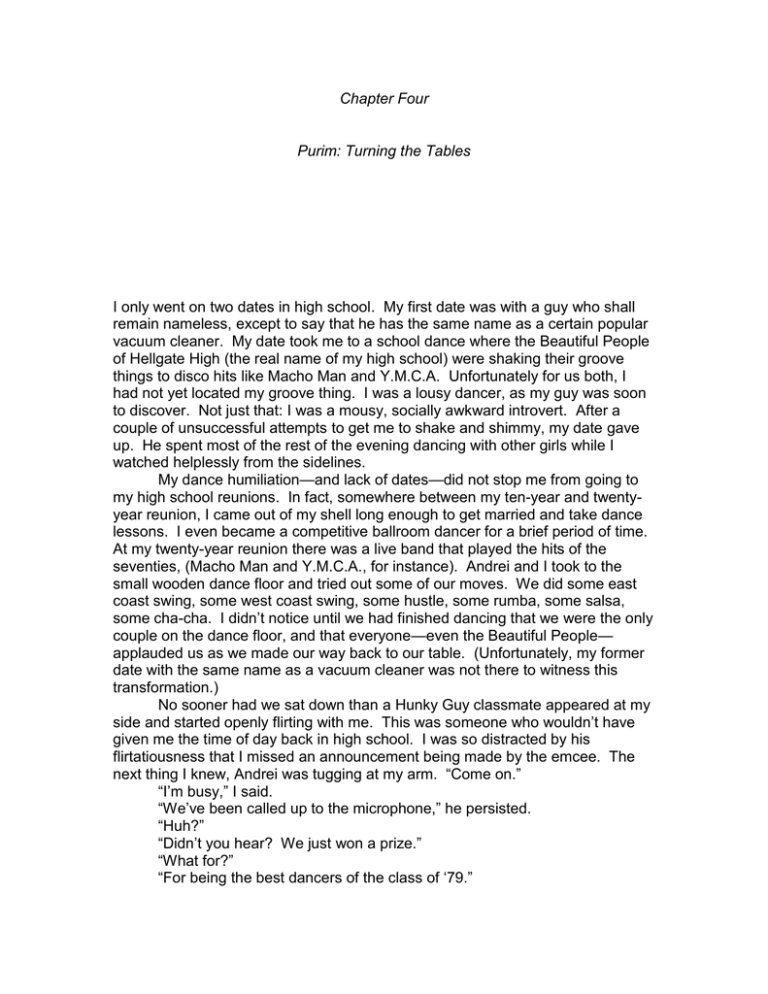
Chapter Four Purim: Turning the Tables I only went on two dates in high school. My first date was with a guy who shall remain nameless, except to say that he has the same name as a certain popular vacuum cleaner. My date took me to a school dance where the Beautiful People of Hellgate High (the real name of my high school) were shaking their groove things to disco hits like Macho Man and Y.M.C.A. Unfortunately for us both, I had not yet located my groove thing. I was a lousy dancer, as my guy was soon to discover. Not just that: I was a mousy, socially awkward introvert. After a couple of unsuccessful attempts to get me to shake and shimmy, my date gave up. He spent most of the rest of the evening dancing with other girls while I watched helplessly from the sidelines. My dance humiliation—and lack of dates—did not stop me from going to my high school reunions. In fact, somewhere between my ten-year and twentyyear reunion, I came out of my shell long enough to get married and take dance lessons. I even became a competitive ballroom dancer for a brief period of time. At my twenty-year reunion there was a live band that played the hits of the seventies, (Macho Man and Y.M.C.A., for instance). Andrei and I took to the small wooden dance floor and tried out some of our moves. We did some east coast swing, some west coast swing, some hustle, some rumba, some salsa, some cha-cha. I didn’t notice until we had finished dancing that we were the only couple on the dance floor, and that everyone—even the Beautiful People— applauded us as we made our way back to our table. (Unfortunately, my former date with the same name as a vacuum cleaner was not there to witness this transformation.) No sooner had we sat down than a Hunky Guy classmate appeared at my side and started openly flirting with me. This was someone who wouldn’t have given me the time of day back in high school. I was so distracted by his flirtatiousness that I missed an announcement being made by the emcee. The next thing I knew, Andrei was tugging at my arm. “Come on.” “I’m busy,” I said. “We’ve been called up to the microphone,” he persisted. “Huh?” “Didn’t you hear? We just won a prize.” “What for?” “For being the best dancers of the class of ‘79.” Nonplussed, I excused myself from Hunky Guy. As Andrei and I made our way up to the microphone, the room exploded with applause. The emcee—a former football player—handed us our award: two free T-shirts with the high school logo. As we did our victory lap back to the table, we held the shirts aloft. A former cheerleader who looked like Michelle Pfeiffer touched me on the arm. “You’re amazing, Shelley.” I’m pretty sure that’s the first time she had ever spoken to me. You may wonder what all of this has to do with Purim. Not much, except for one thing: Purim is all about turning the tables. Purim commemorates the day during the Persian Empire that Queen Esther and her guardian Mordechai thwart Prime Minister Haman’s plan to annihilate the Jews. They instead bring about Haman’s downfall, thereby turning a curse against the Jews into a blessing. The story of Purim is outlined in the Book of Esther and goes like this: The Persian king Ahashverosh chooses Esther--a Jewish orphan being raised by her relative and guardian Mordechai—to be his queen out of all the maidens of the land. He doesn’t realize his new wife is Jewish, so when his conniving prime minister Haman comes up with his plan to kill all Jews, King A. signs off on it. Esther, after consulting with Mordechai, decides to come out of the closet. First, though, she asks that her fellow Jews join her in a three-day fast while she musters her courage. When her loving husband finds out that Esther is really Hadassah, he turns the tables on the evil Haman. Haman dies on the very gallows he’s constructed for Mordechai, while Mordechai is named Prime Minister. Now, instead of being annihilated, Jews celebrate with a lavish feast (and do some annihilating of their own). Esther took a potential weakness (her secret Jewish identity) and turned it into a great strength. Jews have been turning the tables every Purim since. The student becomes the teacher, the leader becomes the follower, the brooding intellectual becomes the extrovert. Fortunately, one of the mitzvot of Purim is to drink lots of alcohol. (I had no idea that I performed so many mitzvot back in college.) Purim is also your one chance during the year to poke fun at your rabbi, and even the Torah. The observance of Purim centers on the reading of the Megillah (the aforementioned Book of Esther), during which audience members boo, hiss, stamp their feet, and twirl their graggers (a Yiddish word for “noisemakers”) whenever the name Haman is spoken. The Megillah is read both on the eve of Purim and on Purim itself. In addition to the two Megillah readings, there are three other mitzvot for Purim: giving out Purim baskets with at least two ready-to-eat food items (known as Mishloach Manot), giving money or food to at least two needy people (Matanot La’evyonim), and attending a festive Purim dinner (Seudat Purim). In order to fulfill the mitzvah of Mishloach Manot, I give baskets to my spiritual friends, Peirce and Jane, who are due at my place for a brunch on the eve of Purim. I opt for Kedem (kosher) grape juice and hamantaschen, triangular pastries-cum-filling meant to resemble either Haman’s ears, or his tri-cornered hat. I initially plan on buying hamantaschen at Safeway, my source for 2 everything Jewish. Unfortunately, hamantaschen are nowhere to be found and I’m left to my own devices. I peruse the Internet and discover a recipe that claims to be the easiest, quickest hamantaschen recipe ever invented. The claim proves to be false. While the end product is tasty, my hamantaschen lack taschen. The dough spreads wide apart in the oven to expose the strawberry underbelly, rendering them ordinary cookies. My husband Andrei attempts to perform emergency surgery on them, but it’s too little too late. That’s when I realize that I’ve overlooked the last line of the recipe, the one informing me to pinch the dough over the filling. My second batch is closer to the way God intended hamantaschen to look, but I probably wouldn’t win any baking awards with them. Still, Peirce and Jane eat them with gusto, and we then read Esther 9:20 – 22 together, where Mordechai entreats the Jews to send portions to one another (Mishloach Manot), to give to the poor (Matanot La’evyonim), and to have feasting and gladness (Seudat Purim). An unexpected blessing of the hamantaschen is the way they bring my family together. We’re a typical busy DC family. My husband works long hours for the government and I spend much of my time driving my son to after-school activities. It’s rare that we sit down as a family to a meal, or work on a project together. Still, when I first start putting together the ingredients, Luke drops everything and assists me. Granted, his main motive is to sample the dough, but the two of us have a great time measuring and mixing. When I pull the dough out of the refrigerator the next morning, Andrei comes to my assistance and muscles the cold hard glob into submission, rolling it into a pliant quarter inch sheet. Similarly, the basket distribution and discussion of Purim enhance my spiritual friends meeting. While I know you’re not supposed to compare Jewish holidays with Christian ones, I can’t help but think of Easter with its theme of rejuvenation, the joyous preparing and disseminating of baskets, and the fact that Purim falls on a spring-like day with the first buds of new life appearing after a long dark winter. The next mitzvah I fulfill is to attend a reading of the Megillah. Once on the eve of Purim, and once on Purim. Ideally, I would go to a synagogue and listen to a rabbi read the megillah. Since I’m a stay-at-home mom with a very busy husband, I can’t always get away when I’d like. So I try to be creative. To be honest, I was going to cheat a little and listen to someone read the Megillah on the Internet, and almost did so until I read a warning at the bottom of the page stating something like, “Don’t even think about using this recording to fulfill your Megillah reading mitzvah…. That means you!” As it turns out, the reading needs to be live, and you need to listen to every word with full attention. Andrei balks at reading the whole Book of Esther to me when he sees how long it is, so we take turns reading chapters to one another. (Nowhere does it say that you can’t listen to yourself reading the Megillah.) Luke is initially tucked away in his room playing a video game. At some point, he wanders into the living room and sits on the couch, listening with rapt attention. Okay, I made that last part up. In reality, he’s restless and fidgety, and interrupts us every five seconds (he serves as our 3 human gragger), but the point is that the Megillah reading becomes another family event. Instead of watching TV or a DVD, checking email or playing video games, the three of us sit on the couch and read to one another, hear the story of Esther and Mordechai. On the day of Purim, which falls on a Sunday this year, I get up early and read the Megillah aloud in the basement while the boys sleep upstairs. I listen in rapt attention to myself. Honestly. From there I make my way to Quaker meeting, as I have nearly every Sunday for the past eight years. Once there, I fulfill the obligation of Matanot La’evyonim by bringing canned goods for Bethesda Cares (an organization that helps the homeless), and give the equivalent of Bethesda lunch money ($8.00) to my meeting’s social concern of the month: The Montgomery Literacy Council. I have meant to contribute to both organizations for months. Purim is what motivates me to pony up. The final stop on my Purim journey is the Seudat Purim (Purim meal), the time of feasting and gladness, a time to wear a costume and get sloshed. But first, I need a costume. The sixteen-year-old clerk at the Party Store looks at me like I’m a few singers short of an opera when I ask her if she has any Queen Esther costumes. “You know. For Purim,” I add. She wrinkles her nose. “Halloween?” I can hardly fault her. I’m fifty and didn’t know from Purim, either. That’s all going to change, I think, as I eye the racks of Cat Woman, Police Woman (of the Micro-Miniskirt Squad) and Nurse Sexy. Tempting, but I don’t think I should go to shul in any of these. “If you’re looking for a queen costume, you may want to check out our renaissance section in aisle four,” the teenager says after wrinkling her nose a few more times. Not a bad idea. I make my way to aisle four and peruse the rack full of Maid Marions, Galley Wenches, and Tavern Ladies until I come to a royal purple Renaissance Queen costume. I think this is about as close as I’m going to get. Why do I want so badly to be Queen Esther? Simple. Because she turned her weakness into a strength, thereby saving her people. (Top that, Catwoman!) I’ve experienced nothing so dramatic as Esther did, but I am well aware of my own shortcomings. I wonder: Can I turn my weaknesses into strengths? My biggest weakness has to be my shyness. I come by this trait honestly: I hail from a long line of Norwegian introverts. No one in my family has ever said the words “Whoo hoo!” or pumped her fist. Not once. Not even my grandfather at his surprise ninetieth birthday party. As he entered the room full of loved ones from all eras of his life—some who had flown in just for the occasion—he simply nodded and said, “Yep. That’s real nice.” I’m pretty sure his heart kept beating at exactly the same pace it beat for all ninety-seven of his years. Similarly, at my fiftieth birthday party—which takes place during this year of Judaism—I try to keep things low-key. I go so far as to cut the cake in the kitchen and have my husband bring guests their slices. This way, I reason, I’ll avoid having people serenade me with the birthday song, and thus avoid being the center of attention. And I almost get away with it. 4 “Shelley? Where are you?” My friend Frank calls out from the other room. “Damn,” I mutter under my breath. I pretend not to hear him and keep cutting the cake. “Come on out here, Birthday Girl,” he persists. I wince and look at Andrei. “Do I have to?” “I’m afraid so.” I pass my bubbly friend Julie on the way back into the living room. I am oh so tempted to ask her to stand in for me. I know she would enjoy the experience so much more than I. But I dutifully stand in the middle of the room as my friends sing me the birthday song. As soon as the song is over, though, I escape back into the kitchen. After all, someone might get the idea to start making speeches, and then (gulp), I might have to make one, too. Why am I so averse to the limelight when there are so many people who can’t get enough of it? I honestly have no idea. All I know is that when I hear Garrison Keiler talk about shy Norwegian bachelor farmers, I think to myself, Those are my people. Sunset is imminent, and I’m ready to make my appearance as Queen Esther. Andrei and Luke accompany me, both wearing crowns. The first indication that Purim is different from other holidays is when the rabbi, whom I’ve never seen in anything but a dark suit and tie, greets us in a loud Hawaiian shirt, Birkenstocks, and a white fishing hat. He looks as if he had just stepped off of a tour bus, only instead of brandishing a Nikon camera, he shakes a pair of brightly colored maracas at us. Scarcely have I recovered from the shock of seeing the rabbi in his Hawaiian get-up when I spot Ruthie wearing a multi-hued Hawaiian skirt cum matching shirt and headdress. She looks like she’s about to tape an ad for Chiquita bananas. There’s no service for Purim, so we head straight for the dining room. A dozen or so costumed people mingle around brightly festooned tables, paper plates in hand. The meal tonight is being served buffet style. A large kitchen counter boasts platters full of salads and barbeque. One large platter is reserved solely for hamantashen. (They look a lot better than mine, I notice.) The costumes represent everything from a black belt karate instructor to super heroes to royalty (kings, queens, princes and princesses) to a couple wrapped in tinfoil and a baby with a black marker beard. If I didn’t know better, I’d think I was at a Halloween party. “Grab some food and have a seat,” the rabbi calls out, shaking a maraca at us. Luke claims his place at the rabbi’s table, next to his friend Benny. Andrei and I take seats across from the young couple dressed in tinfoil with the bearded baby. If there’s such a thing as “looking Jewish,” these two do not fit the mold. The man has silky blond hair and blue eyes, a narrow face and a triangular goatee. The woman, who wears a traditional Orthodox head covering, is Asian. We introduce ourselves to one another, and their names don’t sound that Jewish either: Chris and Carol. “What brings you to JewishRoc?” Andrei asks. 5 “We’ve both been taking classes. Carol’s taking a Kabbalah class and I’m studying Torah with the rabbi. How about you?” “I’m taking Hebrew and working on a book project.” “What’s your book about?” Carol asks. I tell them about my year of studying Jewish holidays as a non-Jew. “We’re non-Jews, too,” Carol says. “But not for long,” Chris adds. “We’re in the process of converting.” “What made you want to convert?” Andrei asks. Chris leans forward and clasps his hands on the table in front of him. “We were stationed in Alabama. We’re both in the military. We attended this fundamentalist church every Sunday and handed out religious pamphlets on street corners on Saturdays, telling people they were going to burn in hell if they didn’t accept Jesus as their lord and savior. And we really believed it.” “We were serious born again Christians,” Carol chimes in. “Hard core,” Chris adds. “How did you end up at JewishRoc?” Carol takes up where Chris left off. “In spite of our strong commitment to our church, we both felt some kind of void, like there was something missing in our lives. We just didn’t know what.” Chris nods. “So we started reading books about other religions. Buddhism, Hinduism, Islam, you name it. One day I read a book on Judaism. I read the book in one sitting. When I finished the book, I knew Judaism was for me. Then Carol read the book, and she felt the same way. We left our church and never looked back. We googled ‘conversion to Judaism’ and found JewishRoc. When we read about the program here, we packed our bags, left Alabama, left Christianity, and bought a house in Rockville near a shul.” “Now we just need jobs,” Carol says. “Which Hashem will provide,” Chris adds. The baby starts to cry. Carol goes on to tell us about keeping a kosher kitchen and finding a job that will let them keep the Sabbath. The baby with the beard starts to fuss, and Carol and Chris become distracted. I use the pause in conversation to ponder what I’ve just heard. If going from a pamphlet brandishing born again Christian to an Orthodox Jew isn’t an example of turning the tables, I don’t know what is. “Next year they’ll be in India in an ashram,” Andrei whispers in my ear. Always the cynic. In the meantime the rabbi does something else we’re not accustomed to having him do: He cracks jokes. A lot of them. And he encourages us to drink excessively. “Drinking on Purim is a mitzvah,” he reminds us. “And maybe then we’ll find the rabbi’s jokes funnier,” Andrei whispers again into my ear. The next item on the agenda is a Purimspiel (a Purim play) produced by the rabbi’s oldest son Yudi. In the play, which is shown on a large TV screen, 6 Yudi plays the part of his father. He portrays his father as a hapless, bumbling guy who’s constantly begging for money (and not receiving it). His students fall asleep on him and he can’t get a minyan together for morning prayers. (Because everyone has overslept.) Unlike the rabbi’s jokes, the purimspiel is pretty funny. I can’t blame Yudi for poking fun at his father. This is the only time of the year he can get away with it. For me, the biggest table turning of the night, though, comes when the rabbi asks me to make a speech. There’s nothing I dislike more than off-the-cuff public speaking. Ugh. Ordinarily I would stand up and give the briefest, most impersonal of speeches and quickly sit back down, hoping no one was paying that much attention. This time, in my flashy Queen Esther costume, I force myself to linger in the spotlight and (cringe) talk about myself. The two glasses of wine I’ve consumed don’t hurt anything. I tell the crowd about how I grew up in Montana amidst cow and horse pastures knowing nothing of Judaism and how I happened into JewishRoc one day and how the study of Judaism has helped an introverted non-Jew find her voice. I very nearly enjoyed making the speech, which proves that everything really is turned on its head during Purim. 7
